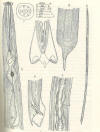|
Female:
Median bulb
well-developed.
Excretory pore anterior to median bulb, at level of stylet knobs.
Basal esophageal bulb elongate-pyriform. Not overlapping intestine. .
Ovaries paired, outstretched, spermathecae present.
Tail tapering abruptly then elongate conoid.
Male: Similar to female.
Spicules slightly arcuate,
gubernaculum straight..
Males have unique caudal alae,
well-developed. Tail tip appears bifurcate in ventral view.
|

Dolichodorus pulvinus
A: Entire female; B:Female tail; C:Female vulval region; D: Male tail
ventral view;
E: Male tail ventral view; F en face view;
G: Anterior region detail.
Source: Khan et al., 1971. |